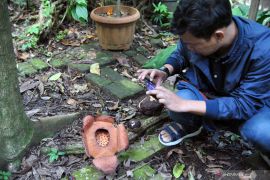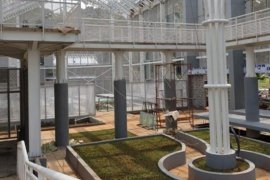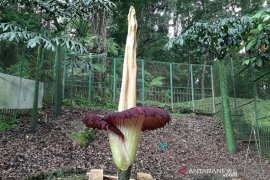In line with the targets of government programs related to the preservation of the environment and the utilization of biological resources, botanical gardens can help reduce carbon emissions to 26 percent.
"Botanical gardens can help manifest the Indonesian governments commitment to reducing carbon emissions to 26 percent," pointed out Chief of Bogor Botanical Garden Plant Conservation Board Didik Widyatmoko in Bogor, West Java, on Monday.
He noted that the botanical gardens could also help conserve and support the potential growth of local plants, besides serving as a natural lab for research, education and tourism.
They may be created to educate the public on plant species or to simply enjoy the beauty of the plant kingdom.
Botanists make botanical gardens to study and preserve indigenous plants or to display a range of non-indigenous plants.
Sometimes, such gardens can specifically rescue plants nearing extinction in their habitats by saving and distributing seeds.
They can be small places open to the public only on a few occasions, or they can be lush plant paradises, where visitors can enjoy the sights and, perhaps, plan a picnic.
Nowadays, such gardens are becoming key players in both the conservation of plants and in the education of the people who come to see them.
They are also starting to play a role in the mitigation of the effects of climate change and could be absolutely vital to the survival of the planet, as they are perfectly placed to help move species around and help ecosystems to adapt to new climates in different regions.
"In light of this, the development of botanical gardens has become the ninth national priority for environmental and disaster management," Didik noted.
Therefore, Bogor Botanical Gardens Plant Conservation Center plays an important role in developing botanical gardens in Indonesia.
Meanwhile, the Plant Conservation Center at the Indonesian Institute of Sciences (PKT-LIPI) has set itself a target of establishing 47 botanical gardens in various regions across the country.
"The PKT-LIPI has initiated the establishment of 47 botanical gardens in Indonesia in its plan of action, which is projected to be realized by 2025," the Chief of the Bogor Botanical Gardens ex-situ conservation Joko Ridho Witono remarked during a seminar on Regional Botanical Garden Development.
Compared to the United States of America, Indonesia has fewer botanical gardens. Even though the United States does not have as diverse an ecosystem as Indonesia, it has more than a hundred botanical gardens, he pointed out.
Joko stated that Indonesia needed 47 botanical gardens in a number of areas, based on an "eco-region" to present regional plants.
Today, Indonesia has only a few botanical gardens. The best known are the Bogor Botanical Garden and the Bali Botanical Garden.
Bali Botanical Garden is unique. It is ideal for botanical research, conservation, education and recreation.
It provides visitors a place to relax in beautiful and peaceful surroundings while learning about how the Balinese people use plants in their daily lives. They also get to learn about many interesting tropical rainforest plants and bird life.
The Bogor Botanical Garden, founded during the Dutch occupation in 1817, is situated right in the center of the city of Bogor and spans some 80 hectares of land.
This garden was founded to research and conserve various plant species in Indonesia.
It has now become the main outdoor attraction of Bogor. It provides a large recreational area to local residents and many passing tourists.
Inside the Bogor Botanical Garden, visitors are fascinated by the collection of giant trees, some of which are more than a hundred years old.
Each tree is tagged with its common name, Latin name, and its time of planting so that visitors can gain some valuable knowledge.
The garden offers visitors a refreshing and educational experience. They learn to appreciate and care for the natural biodiversity. More than one million local and foreign visitors visit the garden annually.
"Therefore, the establishment of new botanical gardens is an important agenda for Indonesia for the better management of its biodiversity, as part of its target of Global Strategy for Plant Conservation (GSPC)," Joko noted.
According to him, the presence of botanical gardens was in line with the 1992 Convention of Biodiversity, ratified under Law No. 5/1994 and stipulated in the Indonesia Biodiversity Strategy and Action Plan (IBSAP).
Since 2011, LIPI has played an active role in establishing 21 regional botanical gardens in 17 provinces in Indonesia in cooperation with the Public Works Ministry and Home Affairs Ministry, he added.
Meanwhile, LIPI Secretary General Djusman Sayuti said the establishment of botanical gardens in the region was part of the national priority program, and the government was concerned for plants in Indonesia.
Djusman also noted that the PKT-LIPI had played a strategic role in its efforts to secure, study and exploit Indonesias wide plant variety.
"With increasing numbers of botanical gardens appearing in various parts of the country, the number of plants being conserved to avoid extinction will also increase," he said.
(O001/INE)
Edited by INE
(O001/KR-BSR/F001)
Reporter: Otniel Tamindael
Editor: Jafar M Sidik
Copyright © ANTARA 2013











